THE MILITARY NURSING SERVICES
***
For in depth information about the administrative and organisational details of the military nursing services in wartime, e.g. pay, conditions, mobilisation, travel, lifestyle, see the new website
*****
Military Nurses - Identifying Uniform
A few photos with some information on the differences in uniforms worn by the different military nursing services and how to tell them apart
THE ROYAL RED CROSS AND THE GREAT WAR
A brief look at a the Royal Red Cross decoration and how its prestige was eroded during the Great War in an effort to reward women for their services to nursing
BRITISH MILITARY NURSES - A GUIDE TO THE SERVICES
A newly-written article explaining the background to the different nursing services working under the auspices of the War Office, caring for the British Expeditionary Force during the Great War published on the website of the Western Front Association
At the start of the Great War Queen Alexandra's Imperial Military Nursing Service was just three hundred members strong. These women were to form the heart of the wartime nursing service, but who were they and what was their background? This article supplies information and some statistics on the army's elite group of early twentiety century nurses.
***
Army Nursing Service
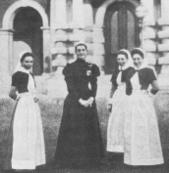
The Army Nursing Service had its roots in the post Crimean War period of the 1850s, although it took many years for it to flourish. The first six female nurses were employed at Woolwich in 1861, and were joined by six more when the Royal Victoria Hospital, Netley, opened two years later. This establishment of twelve nurses remained unchanged until 1882, when the military Campaign in Egypt resulted in a carefully selected group of women being sent to nurse the wounded.
Following the promulgation of new regulations for the service in 1883, there was a steady increase in establishment. By 1890 there were sixty nursing sisters working in sixteen military hospitals, and by 1898 this had increased to seventy-two. Throughout the period this small number was augmented as necessary by members of the National Aid Society [forerunner of the British Red Cross Society], and later by the Princess Christian Army Nursing Service Reserve. The difficulties of raising and maintaining a large nursing service during the Second Boer War [1899-1902] resulted in major reorganisation which ensured a well-trained, professional group of nurses to care for the British Army of the twentieth century.
Records of service for this small group of women are incomplete, but those that do survive provide an excellent source of information on their movements, and varying amounts of personal detail. Some continued to work during the Great War, and others returned from retirement to do so - for these there is a good chance of records surviving.
***
Queen Alexandra's Imperial Military Nursing Service
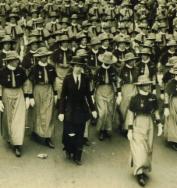
In March 1902, Queen Alexandra's Imperial Military Nursing Service [QAIMNS]replaced, by royal warrant, the Army Nursing Service. Some members of the ANS chose not to transfer to the new service, and it also provided an opportunity to retire or dismiss a few who were deemed unsuitable for the new service. But most of the sixty-seven women who were accepted were granted senior positions as Matrons and Sisters of military hospitals, and took their wealth of experience with them.
The service expanded steadily, although the high standards imposed on new applicants meant that it was always under establishment, and relied on members of the Army Nursing Service Reserve to fill gaps in staffing throughout the pre-war period. Members of QAIMNS were all over the age of 25, single [or just possibly widowed], educated, of impeccable social standing, and had completed a three year course of nurse training in a hospital approved by the War Office. Difficulties in recruitment soon resulted in some slight relaxation in the number of 'approved' institutions, but insistence on the women being of a 'certain' social class was strongly adhered to.
At the outbreak of the Great War, there were 297 trained nurses of QAIMNS serving in military hospitals throughout the world, and despite the enrolment during wartime of nearly 11,000 members of the Reserve, the small size of the regular service was maintained throughout, thus avoiding a surplus of staff that would be difficult to get rid of when war was over. It was not until the spring of 1919 that a well considered plan of expansion started, and the Service grew once again.
Little official information remains for those women who joined QAIMNS from 1902, but resigned prior to 1914 and did not return for wartime service. However, some details can often be traced through nursing journals of the time, and, if they continued to work as nurses after 1922, through the registers of the General Nursing Council. Unfortunately, resignation often preceded marriage and a lifetime of devotion to a different sort of duty - the change of name, and an exit from nursing can make further research difficult. If a woman served at any time during the Great War there is a good chance [though not a definite one!] that she will have a personal file at The National Archives. Files for those who served during the Second World War are still retained by the Ministry of Defence, although information can often be found at The National Archives for the few who served in both world wars.
***
Queen Alexandra's Imperial Military Nursing Service Reserve
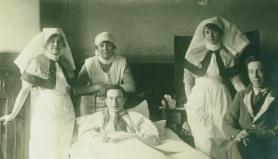
Although there had always been a small 'Reserve' of women who augmented the numbers of the regular QAIMNS, the effects of the Great War demanded that many more women needed to be recruited quickly. The figures for enrolment vary, but one reliable source shows that 10,404 women joined Queen Alexandra's Imperial Military Nursing Service Reserve between August 1914 and the Armistice.
Like their counterparts in the regular service, these women were educated, of good social standing and had all completed a three year nurse training in a hospital approved by the War Office. They were, with very few exceptions, over 25 years of age and single, but as the war progressed a shortage of staff resulted in some married women being allowed to serve. Women were engaged on yearly contracts or until their services were no longer required, and most had been demobilized by the end of 1919, to return to civilian life.
The majority of women who served with QAIMNS Reserve during the Great War have personal files at The National Archives, although these files were 'weeded' during the 1920s and 30s and much of interest has been lost. Combining the information that remains, with details of medals and awards, articles from nursing journals and family history sources, a full picture can often be built up. Files for most women who went on to serve in WW2 are still closed and remain with the Ministry of Defence, while those for women who died after demobilization and before about 1930, have, in the main, been destroyed.
***
Territorial Force Nursing Service
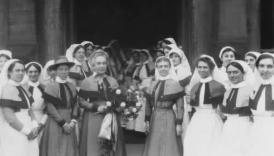
The Territorial Force Nursing Service was formed in 1908 as a result of the Territorial and Reserve Forces Act of 1907. It provided a nursing service for the Territorial Force, and was intended to staff twenty-three territorial military hospitals in the United Kingdom. The women who enrolled in the service from 1909 were civilian nurses who continued to work in their usual capacity, but had undertaken to be mobilised at short notice in case of war.
The TFNS proved popular in peacetime, and following the outbreak of war in August 1914 it expanded rapidly, with 8,140 women having enrolled by the Armistice, of whom 2,280 served overseas alongside their colleagues in QAIMNS and the Reserve.
Standards of entry and conditions of service were identical to QAIMNS Reserve, with only slight differences in uniform distinguishing the two services. After the war, most of the women continued to serve as demobilized members of the TFNS, going back to civilian life, but retaining their commitment to be mobilized again if the need arose - and many did just that - forming the experienced core of the service that went forward into the next war.
Many women who served with the TFNS have personal files at the National Archives, but a smaller proportion survive than for the QAIMNS Reserve, probably reflecting the greater proportion who served in WW2 and whose files are still with the Ministry of Defence. Members of the TFNS were originally recruited locally, but no traces of their original application forms have been found in County Record Offices and archives. This results in less personal information being contained in the files, but they remain an excellent source for tracking these nurses through the Great War.
More information on the Territorial Force Nursing Service between 1908 and 1921 can be found here:
Territorial Force Nursing Service 1908-1921: An Outline
Territorial Force Nursing Service - Post-war summary
***
Queen Alexandra's Military Nursing Service for India
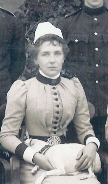
The Indian Nursing Service was inaugurated in 1888 when 2 Superintendent Nurses and 8 Sisters were sent to India, and worked alongside a complementary service formed by Lady Nora Roberts a year previously.
By 1893 the number had risen to 52, working at main Stations throughout India, with two or three Sisters at each, and sometimes working singly. Although their duties were intended to be of a supervisory nature, the lack of any dedicated corps of medical orderlies in India resulted in long and arduous working hours, assisted only by native servants, and a transient population of untrained regimental orderlies. Both the climate and the prevalence of disease caused the breakdown in health, and lifelong debility for many women who lived and worked in India during this period, but despite this, the Indian Nursing Service was popular, and never lacked applicants.
In 1901 moves were made to amalgamate the Indian Nursing Service into QAIMNS, but protracted correspondence shows that there were serious concerns by the India Office that terms and conditions of service would be detrimental to the INS. There was particular resistance to the introduction of the grade of Staff Nurse, as it was seen as unacceptable to their members, the most junior of whom had always held the grade of Sister.
1903 the name was changed to Queen Alexandra's Military Nursing Service for India [QAMNSI], and the establishment rose slowly to a total of ninety-one. Surviving records for these women are held at the British Library, and consist mainly of application papers, letters from referees and indexed ledgers of those both accepted and refused. The service and postings of those who succeeded can be traced through the Indian Army List. Seventeen members of the Indian Nursing Service served on the Western Front and in Mesopotamia during the Great War
Queen Alexandra's Nursing Service India was eventually amalgamated with QAIMNS, finally becoming united in 1926.
***
Queen Alexandra's Royal Naval Nursing Service
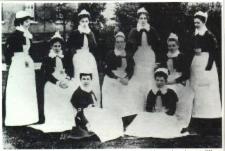
Although women had been employed in naval hospitals from 1744, the Naval Nursing Service was established in 1884 to provide a professional organisation that reflected the improvements taking place both in civilian hospitals and within the Army Nursing Service. In 1902 organisational changes resulted in Queen Alexandra giving her name to new nursing services for both Army and Navy, a move that was welcomed on all sides.
It was always a small service; in 1884 eleven women were employed at Plymouth and Chatham and by 1919 there were eighty-one members of the regular service, assisted by just over 200 Reserve nurses employed during wartime, providing care at fifteen naval hospitals and on nine hospital ships. It was not until WW2 that the regular establishment increased substantially.
Service records are held at The National Archives for all women who served with Queen Alexandra's Royal Naval Nursing Service up to 1926, both 'regulars' and 'reserves'. They comprise microfilmed ledger pages, similar to other naval service records, and while they don't contain the letters, memoranda and similar items held in files of army nurses, they do give a complete picture of all postings during the period of employment.
NEW: Queen Alexandra's Royal Naval Nursing Service index of members and notes on their records